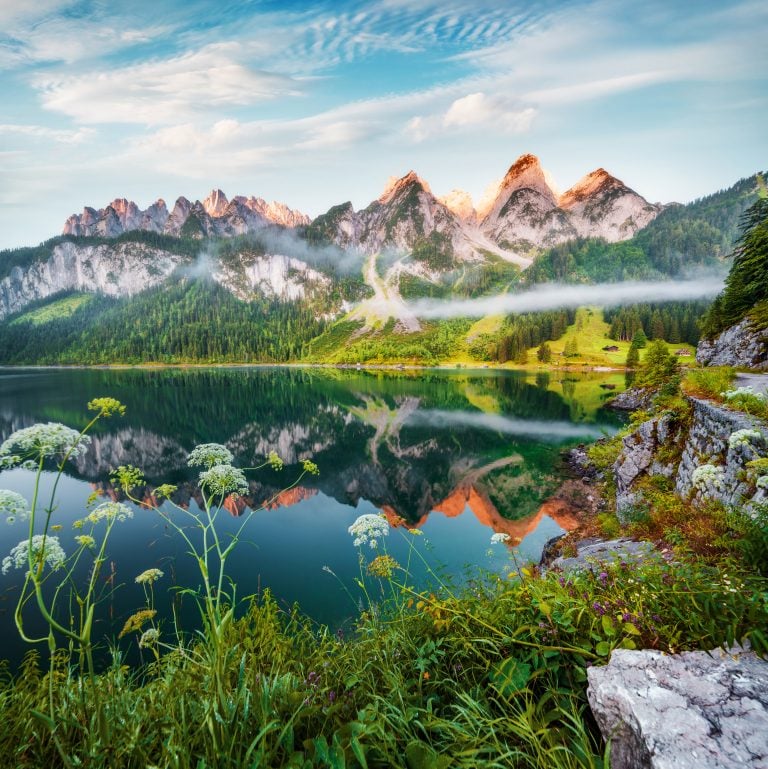The bears are here contemplating the half-eaten porridge, smashed furniture, crumpled beds and a sleeping Goldilocks. Someone will have to pay for this mess, maybe Goldilocks, with her life, as she snores through the bear environmental damage report. Of course, in the fairy-tale version, the little girl, startled by a righteously angry baby bear wakes to the danger… just in time.
In the real world, the aggressive Covid-19 pandemic has perhaps sounded a similar last-minute wake-up alert to a global population snoozing through a period of environmental degradation that threatens its very existence.
Despite the terrible loss of life and an unfolding economic catastrophe, the coronavirus story could ultimately offer humanity hope and the opportunity to escape the mother of all bearish endings: out-of-control climate change.
Fortunately, the coronavirus crisis is neither small enough to ignore, nor so large it overwhelms the ability of societies to respond. If the global pandemic is just the right size, we must not let the enormous sacrifices in this crisis be without some benefit for the longer term; the time is right for a substantial rethink of how we tackle the climate emergency.
Over recent years there has been a growing awareness among large swathes of the population that humanity’s collective fate is inextricably linked to that of the natural world, which the planetary scale of the current viral infection has only reinforced.
The coronavirus outbreak has already triggered fundamental adaptations in consumer and social behaviour, some of which may be permanent. But governments and businesses also must innovate at a faster pace if we are to transform the crisis into opportunity.
While anxiety may have trumped creativity in the short-term, the sharp break from previous behavioural patterns could open our minds to new possibilities as we emerge from the crisis-fugue into a clear vision of a long-term just-right future, free of broken homes and angry bears.
The challenge
Global temperatures are on track to break through the 1.5°C increase threshold compared to pre-industrial levels sometime in the next five years, according to a recent study published by the World Meteorological Organisation (WMO).
The WMO report dashes hopes that the world can meet the 2015 Paris climate accord goal of keeping global warming under that very same target of 1.5°C to avoid serious environmental risks.
Based on research by the UK Met Office, the WMO study rates the odds of global temperature rising above the critical threshold in any annual period before 2024 at one-in-five; and the world has a 70% chance of topping the 1.5°C mark in any one or more months during the next five years.
Prior to the WMO research, most other studies estimated there was a 10% possibility of breaching the global warming danger level in the short term – a risk that has now doubled and rising further, climate models suggest.
Figure 1. The odds of global temperature rising above the critical threshold are rising
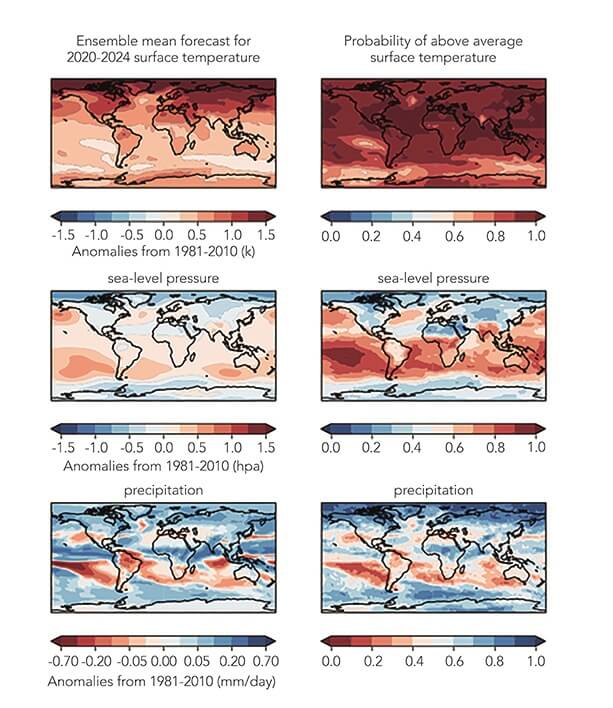
Source: WMO, as at July 2020. The ensemble mean forecast for 2020-2024 is expressed as anomalies with respect to 1981-2010 climatology: top: temperature (left column) and probability of above average (right column), sea-level pressure (middle) and precipitation (bottom). As this is a two-category forecast, the probability for below average is one minus the value in the right column.
The WMO study considers natural climate variability as well as the impact of carbon emissions from human activities, although the models don’t take account of the fall-off in CO2 emissions caused by the coronavirus pandemic.
Nevertheless, the WMO report highlights why the Covid-19 slowdown in CO2 output does little, if anything, to halt the onward march of global warming. Given the long lifetime of CO2 in the atmosphere, the brief slump in emissions during global lockdowns can’t reverse the temperature increases locked-in via existing greenhouse gas.
While images of smog-less cities have provided a glimpse of pollution-free nirvana, the, likely short-term, covid-related reduction in CO2 production is no substitute for sustained and co-ordinated climate action.
Building a framework that links two crises
But we can build a framework that links the Covid-19 crisis to the climate emergency (see figure 2) as shown here by the RSA.
Figure 2: Connecting Covid-19 to the climate emergency
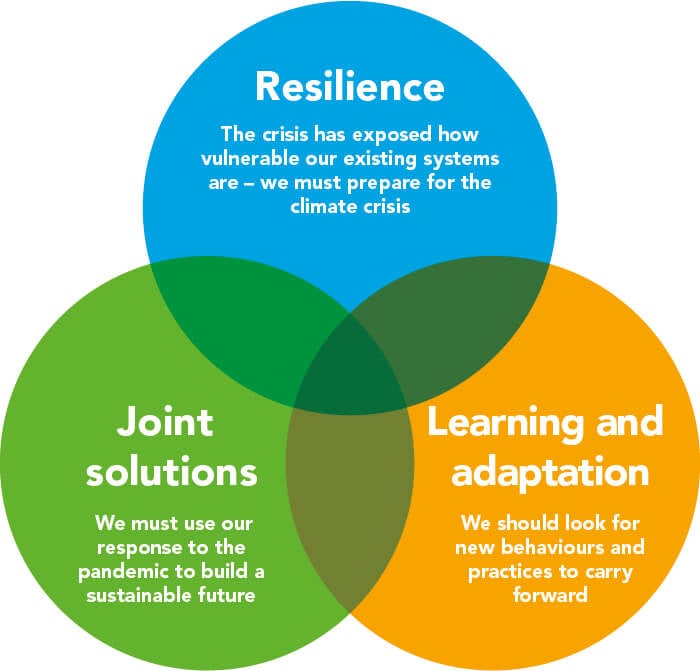
Source: The RSA, as at May 2020.
By considering the issues in concert we can develop solutions to the pandemic crisis that align with the long-term climate agenda, covering factors such as:
- how Covid-19 aid money can be used to speed up the transition to the green economy; and,
- weaving environmental, social justice and economic threads into crisis response plans.
Furthermore, the pandemic has exposed the vulnerabilities in our existing systems and why we need to make them more resilient. Specifically, the pandemic could provide valuable lessons for how the world can cope with and adapt to climate change-related disruption to global food supplies, increased drought, mass migration and the like.
The coronavirus and the climate crisis: joint solutions
To date, there have some successes in ‘joined-up thinking’ around the fiscal responses to coronavirus stimulus packages and long-term climate change planning.
For instance, the European Union, France, the UK and Canada have attached some green strings to emergency spending programs. But, as figure 3 illustrates, three of the world’s largest economies, and biggest polluters – the US, China and India – have, disappointingly, failed to tackle climate change in their immediate Covid-19 rescue budgets.
Figure 3. Mixed green spending patterns
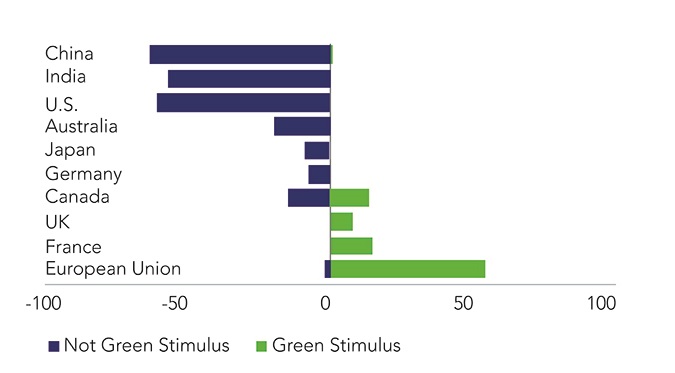
Source: Bloomberg, Vivid Economics, Generation Investment management. Note: stimulus spending on an indexed scale of -100 to 100 to agriculture, energy, industry, transport and waste industries.
But with a quick economic recovery far from assured, governments will probably have to commit to multi-year fiscal packages, providing further opportunities to include climate-change funding based on sustainable finance methods.
Generally, within sustainable finance there are two distinct models, namely:
- use of proceeds: where the issuer or borrower is committing to a sustainability-related spend or allocation of the proceeds of the financial instrument; and,
- performance-based: where the issuer or borrower is committing to future improvements in sustainability related outcomes.
Figure 4. Sustainable finance fixed income models
Use of proceeds | Performance based | |
|---|---|---|
Application of funds | Earmarked application of funds for pre-defined green/social/sustainable projects/assets | General purpose (not monitored) |
Description | Commitment to a spend or allocation | Commitment to a future outcome, forward looking |
Focus | Impact of proceeds from financial instrument | Impact created by issuer/borrower |
Set-up | Investments in green/social/sustainable assets/projects | Sustainability targets |
Impact | Green/social/sustainable benefit created through investment | Change in sustainability profile of issuer/borrower |
Outcome | Outcome monitored without quantified expectations on impact | Outcome monitored with clearly documented expectations on impact |
Structure | The structure of the financial instrument is not adjusted | The financial or structural characteristics are linked to the outcome of the performance (e.g. through triggering variations in coupon or margin) |
Typical type of instrument | Drawn proceeds under bonds and loans | Undrawn commitments under loan structures and drawn proceeds under bond and loan structures |
Financial instrument | Green bonds
Social bonds Sustainability bonds Green loans | Sustainability linked loans
Sustainability linked bonds |
Source: SEB Climate and Sustainable Finance.
We believe performance bonds could play a much larger role than they are currently in meeting sustainable finance targets. Performance bonds could be issued by sovereigns or corporates under terms that link interest payments to achievement of real climate-change goals.
According to our research, such climate-linked bonds should be relatively cheap to issue while providing strong financial incentives for the issuer to meet the sustainability targets:
- If issuers achieve the measurable climate goals, they pay a lower coupon rate to bondholders; and,
- conversely, missing the sustainability targets will see issuers pay higher rates to debtors.
In short, performance bonds offer an incredibly simple way for governments, and companies, to bundle their financing needs with practical climate change action.
Learning and adaptation
The Covid-19 crisis coincided with, and reinforced, a huge shock to energy markets. Already low oil prices, for example, sank briefly into negative territory early soon after the virus-led lockdowns vaporised demand.
And if research suggesting that nine out of 10 existing trends would accelerate further post-crisis is accurate, then the decline of fossil fuels and rise in sustainable energy solutions should continue apace.
At the same time, falling renewable energy costs should help the transition away from high-carbon fuels and enable alternative power systems to scale-up.
Clearly, such a dramatic shift in a key sector will have a major impact on employment, requiring retraining for many thousands of workers in that industry alone. The coronavirus crisis has already shown that the burden of change falls unequally across societies, revealing pre-existing fractures and structural unfairness.
But the current disruption can indicate how to build better social safety nets as well as identify, and reward, a wider range of ‘essential’ workers.
In some ways, too, education – especially targeted to historically neglected cohorts such as females in many developing countries – could be as an effective a weapon against climate change as any new-fangled technology. Educating a broader section of society about the climate change risks should spur more individuals to make necessary lifestyle adaptations and develop innovative solutions.
Ground-breaking technology, however, remains a necessary part of the green equation. Europe, for instance, is pinning much of its sustainable hopes on hydrogen energy projects that will see hundreds of billions of euros flow into clean technology investment as part of the climate-friendly coronavirus economic recovery program.
The hydrogen investment prospect is in its relative infancy. Currently, most hydrogen is produced from reasonably high-carbon energy sources such as natural gas – so-called ‘grey’ hydrogen. ‘Blue’ hydrogen production techniques step up the climate case for the fuel source by using ‘carbon capture’ methods.
But the falling cost of renewable energy and more efficient water electrolysis processes, signal the dawn of a new ‘green’ hydrogen era where the clean-burning fuel is extracted with a zero carbon-footprint to boot.
Figure 5. An overview of hydrogen production routes
Type of hydrogen | Grey | Blue | Green |
|---|---|---|---|
Production route | Natural gas reforming/coal gasification | Natural gas reforming/ coal gasification + carbon capture | Electrolysis of hydrogen compounds |
Cost (USD/kg) | 1.0-1.5 | 1.5-2.5 | 4.0-6.0 |
Pro | Relatively cheap, commercially widespread | Carbon neutral | Zero carbon (where power source is renewable) |
Con | High carbon emissions | High CCS investment costs | High capex and water intensive |
Source: HSBC.
Hydrogen appears to have reached a tipping point for growing adoption as falling costs converge with rising demand post Covid-19 from nations seeking to reduce their dependence on fossil fuel supply chains. The higher energy density of hydrogen and its superior storage capabilities can help overcome certain renewable energy deficiencies, decarbonise hard-to-electrify industrial processes, and accelerate the electrification of heavy-transportation systems.
Figure 6: Hydrogen uses
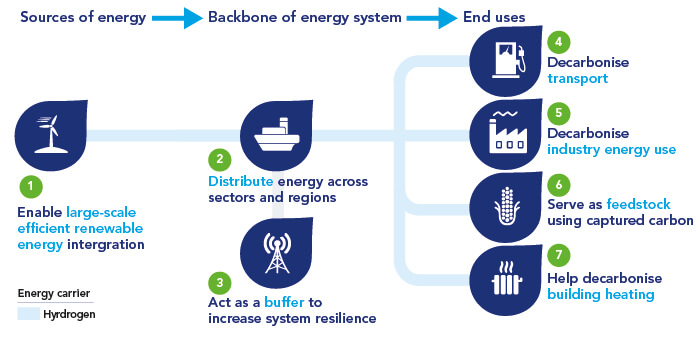
Source: Hydrogen Council.
In particular, hydrogen holds much promise in the long-haul heavy goods vehicle (HGV) segment where it has two key advantages over battery-powered electric trucks, namely:
- lower weight leading to longer range; and,
- rapid refuelling time.
As long-haul transport typically moves along the main road arteries, hydrogen requires far fewer refuelling stations compared to more localised transport, such as cars.
Resilience is key
The direct link between climate change and the coronavirus pandemic is showing up in other unexpected places such as air pollution. In addition to already increasing air pollution in cities brought on by industrial processes and fossil fuel transportation, the world has recently seen a surge in wildfires, exacerbated by global warming.
Research, including a study by the Harvard University T.H. Chan School of Public Health, has shown that coronavirus patients in high-pollution zones are more likely to die from the infection than those living in cleaner parts of the world. The science illustrates how an immune system overwhelmed by smoke and other pollutant particles is less able to fight off viruses – an effect that likely lasts for months after initial exposure.
We can find many other similar examples where coronavirus and climate change intersect.
Our experience with Covid-19 has shown the vulnerabilities of our current system, but also offers hope that we can make the required changes to our way of living. The crisis has brought home the message that slowing the planetary march towards climate catastrophe is a central issue for all of us.
But how do we move from acknowledgement to action?
A recent report by the Global Commission on Adaptation estimates the world must spend $1.8 trillion by 2030 to prepare for the effects of global warming. The report is a stark reminder that climate change is happening and while we can’t hold it back entirely, there are ways to mitigate the effects.
Coincidentally, the annual global military expenditure is also about $1.8 trillion. Despite the massive sums involved (a figure governments seem happy enough to splash out on defence), the suggested investment in climate change action would yield $7.1 trillion in benefits, the Commission says, with the payoff primarily associated with projects such as:
- weather warning systems;
- infrastructure improvements;
- dry-land farming;
- mangrove protections; and,
- water management.
The Global Commission on Adaptation report holds much detail on promising climate change action strategies. For example, the study reveals how disseminating reliable storm information just one day in advance can cut resulting damage by an estimated 30% – equating to a $16bn saving in annual costs for an upfront investment of just $800m.
Elsewhere, the report shows how existing initiatives such as providing drought resistant seeds to small farms have already increased yields in vulnerable nations like Zimbabwe.
But, of course, readying the world for a new climate reality, building our resilience, is only part of the story – we must also focus on slowing global warming itself as far as possible.
The time is now for climate action
The choices that we make now and in the next few years will shape the global economy for decades to come. Rather than seeing the Covid-19 crisis as a distraction from the climate change challenge, we should use it as a spur to action and a chance to get our house in order before the bears notice.
In the most popular version of the fairy tale, Goldilocks escapes from the three angry bears, through the forest and, presumably, back home. We need a better ending than that: humanity has to wake up to the fact that no-one else is going to clean up our mess – it’s just right.



